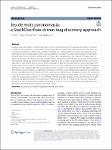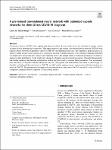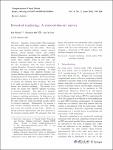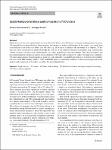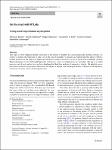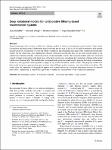Search
Author
- Jorgensen, Ed (3)
- McFadyen, Ron (3)
- Nora, El-Rashidy (3)
- Christian, Homeyer (2)
- next >
Subject
- programming (10)
- Open Access (8)
- Java (7)
- Programming (7)
- next >
Date issued
- 2020 - 2025 (293)
- 2010 - 2019 (39)
- 2000 - 2009 (2)
- 1999 - 1999 (1)
Has File(s)
- true (335)
Search Results
Locating bug code snippets (short for BugCode) has been a complex problem throughout the history of software security, mainly because the constraints that define BugCode are obscure and hard to summarize. Previously, security analysts attempted to define such constraints manually (e.g., limiting buffer size to detect overflow), but were limited to the types of BugCode. Recent researchers address this problem by extracting constraints from program documentation, which shows the potential for API misuse. But for bugs beyond the scope of API misuse, such an approach becomes less effective since the corresponding constraints are not defined in documents, not to mention the programs without documentation In this paper, inspired by the fact that expert programmers often correct the BugCod... |
Promoting the social-emotional development of kindergartners is of special relevance as will lay the foundations for emotion regulation in later childhood and adulthood stages. Considering that tangible storytelling tables are already used for language and literacy skills in kindergarten, we addressed the problem of designing a storytelling intervention aimed at social-emotional development suitable in such a context by using an emotional laden story as content and embedding a guidance method that can be implemented with either a human or robot guide to enhance the learning setting. |
Swarm robotics studies how to use large groups of cooperating robots to perform designated tasks. Given the need for scalability, individual members of the swarm usually have only limited sensory capabilities, which can be unreliable in noisy situations. One way to address this shortcoming is via collective decision-making, and utilizing peer-to-peer local interactions to enhance the behavioral performances of the whole swarm of intelligent agents. In this paper, we address a collective preference learning scenario, where agents seek to rank a series of given sites according to a preference order. |
Coronavirus disease (COVID-19) is rapidly spreading worldwide. Recent studies show that radiological images contain accurate data for detecting the coronavirus. This paper proposes a pre-trained convolutional neural network (VGG16) with Capsule Neural Networks (CapsNet) to detect COVID-19 with unbalanced data sets. The CapsNet is proposed due to its ability to define features such as perspective, orientation, and size. Synthetic Minority Over-sampling Technique (SMOTE) was employed to ensure that new samples were generated close to the sample center, avoiding the production of outliers or changes in data distribution. |
Recently, virtual reality (VR) technology has been widely used in medical, military, manufacturing, entertainment, and other fields. These applications must simulate different complex material surfaces, various dynamic objects, and complex physical phenomena, increasing the complexity of VR scenes. Current computing devices cannot efficiently render these complex scenes in real time, and delayed rendering makes the content observed by the user inconsistent with the user’s interaction, causing discomfort. Foveated rendering is a promising technique that can accelerate rendering. |
Depth sensors of low-cost acquisition devices (e.g. Microsoft Kinect, Asus Xtion) are coming into widespread use; however, 3D acquired data are generally large, heterogeneous, and complex to analyse and interpret. In this context, our overall goal is the analysis of the action of a subject in a 3D video, e.g. the action of a human or the movement of its subparts. To this end, the action classification is achieved through the analysis of the temporal variation of geometric (e.g. centroid path, volume variation, activated voxels) and kinematic (e.g. speed) properties in consecutive frames. Then, these descriptors and the corresponding histograms are used to search a frame in a 3D video and to compare 3D videos. |
This open access book constitutes the proceedings of the 8th International Conference on Principles of Security and Trust, POST 2019, which took place in Prague, Czech Republic, in April 2019, held as part of the European Joint Conference on Theory and Practice of Software, ETAPS 2019.
The 10 papers presented in this volume were carefully reviewed and selected from 27 submissions. They deal with theoretical and foundational aspects of security and trust, including on new theoretical results, practical applications of existing foundational ideas, and innovative approaches stimulated by pressing practical problems. |
This paper is about shipping runtime verification to the masses. It presents the crucial technology enabling everyday car owners to monitor the behaviour of their cars in-the-wild. Concretely, we present an Android app that deploys RTLOLA runtime monitors for the purpose of diagnosing automotive exhaust emissions. For this, it harvests the availability of cheap Bluetooth adapters to the On-Board-Diagnostics (OBD) ports, which are ubiquitous in cars nowadays. The app is a central piece in a set of tools and services we have developed for black-box analysis of automotive vehicles. |
The COVID-19 pandemic has severely affected the lives of people worldwide, and consequently, it has dominated world news since March 2020. Thus, it is no surprise that it has also been the topic of a massive amount of misinformation, which was most likely amplified by the fact that many details about the virus were not known at the start of the pandemic. While a large amount of this misinformation was harmless, some narratives spread quickly and had a dramatic real-world effect. Such events are called digital wildfires. In this paper we study a specific digital wildfire: the idea that the COVID-19 outbreak is somehow connected to the introduction of 5G wireless technology, which caused real-world harm in April 2020 and beyond. |
Deep learning provides accurate collaborative filtering models to improve recommender system results. Deep matrix factorization and their related collaborative neural networks are the state of the art in the field; nevertheless, both models lack the necessary stochasticity to create the robust, continuous, and structured latent spaces that variational autoencoders exhibit. On the other hand, data augmentation through variational autoencoder does not provide accurate results in the collaborative filtering field due to the high sparsity of recommender systems. |

